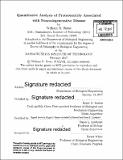Quantitative analysis of proteotoxicity associated with neurodegenerative disease
Author(s)
Hesse, William R. (William Reichard)
DownloadFull printable version (23.27Mb)
Other Contributors
Massachusetts Institute of Technology. Department of Biological Engineering.
Advisor
Roger D. Kamm and Susan L. Lindquist.
Terms of use
Metadata
Show full item recordAbstract
Neurodegenerative diseases are a costly burden, both economically and in terms of human suffering. A common feature of neurodegenerative diseases is that they stem from problems with protein folding, but the underlying biology that leads to neuron death is not well understood. Due to this lack of mechanistic information there are currently no therapeutics that treat underlying mechanisms that lead to cell loss. This thesis explores the link between complications in protein folding and cell death. In the first part of this thesis, I combined modeling of the proteotoxicity of polyglutamine (as exemplified in Huntington's Disease) in Saccharomyces cerevisiae with microfluidics and automated microscopy. From these studies, I have found that glutamine-rich proteins suppress the toxicity of poly-glutamine expanded Huntingtin by physically interacting and sequestering the protein at the IPOD (insoluble protein deposit) quality control compartment. These studies have provided new insight into possible therapeutic strategies and how the proteomes of different cell types may protect or sensitize sells to specific proteotoxic stresses. In the second part of this thesis, I quantitatively and systematically studied the toxicity of a-synuclein, which is implicated in the synucleinopathy family of diseases, including Parkinson's Disease. To systematically study the effect of toxic levels of a-synuclein expression on cellular homeostasis, I constructed a library of fluorescent reporters and utilized automated, high-throughput microscopy to image changes in reporter localization and abundance in response to a-synuclein toxicity. The results from this study have illuminated a number of pathways that were not previously studied for a-synuclein toxicity and have tied together disparate findings from many other studies. Additionally, I have shown that our experimental strategy is generalizable and can be applied other yeast models of neurodegenerative toxicity, such as poly-glutamine and AO 1-42. In summary, the quantitative studies presented in this thesis have expanded our understanding of the mechanisms underlying a variety of toxicities related to neurodegeneration. The biological insights gained from these studies have helped illuminate new areas of inquiry that may be used to combat these diseases.
Description
Thesis: Ph. D., Massachusetts Institute of Technology, Department of Biological Engineering, 2017. Cataloged from PDF version of thesis. Includes bibliographical references (pages 125-147).
Date issued
2017Department
Massachusetts Institute of Technology. Department of Biological EngineeringPublisher
Massachusetts Institute of Technology
Keywords
Biological Engineering.